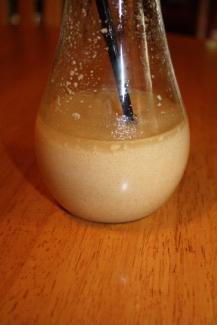Are There Different Amounts of Iron In Different Brands of Cereal?
|
|
| Grade Level: | 1st-5th |
| Difficulty: | 2 |
| Time Required: | Less than 1 day |
| Materials: | Readily available |
| Cost: | Low |
|
Experimental Procedure:
- Choose several kinds of breakfast cereal to test. For each cereal, you will need 2 cups for the experiment.
- Put in the 2 cups of cereal in the blender and add about 2 cups of distilled water.
- Blend the water and cereal on high until you have a smooth slurry and there are no visible lumps or chunks of cereal left.
- Carefully pour the slurry into a clear plastic or glass cup. Label the cup with the name of the cereal you are testing.
- Rinse the blender with a small amount of water (20 mL) and pour into the cup.
- Hold the magnet against the outside of the cup and slowly stir the slurry with a plastic spoon.
- While you are stirring the cereal, you may notice iron particles collecting near the magnet on the inside of the cup where you are holding the magnet. Continue to stir for 1 minute.
- Carefully pour off the cereal slurry. Be very careful not to move the magnet from the side of the cup, or to disturb the pellet of iron collected on the magnet.
- Add 200 mL of water to the cup and stir for an additional minute. This will clean the pellet of iron of any cereal debris.
- Carefully pour off the water. Be very careful not to move the magnet or to disturb the pellet of iron.
- Leave the plastic cup to air-dry for 1?2 hours. Choose a location that is not windy or breezy so that your cups will not tip over.
- If you like, transfer your iron powder to a square of plastic wrap. Carefully fold the plastic wrap over a few times to seal in the iron powder. Label each square with the type of cereal the iron powder came from using a permanent marker. Now you can attach your iron collection to your poster!
- Repeat the above steps for each cereal you are testing.
- Create a scale for rating the amount of iron in each pellet. A very simple scale, using only four states, could be: not present, small pellet, medium pellet, or large pellet. Be sure to write the code for your scale on your poster so that others will know how you scored your results.
- Write your data in a data table
- Make a scatter plot of your data. Make a scale of the percent daily value of Iron on the left side (y-axis) of the graph. Make a scale of the "Relative Iron Pellet Size" on the bottom (x-axis) of the graph. Draw a symbol for each type of cereal where the "Relative Iron Pellet Size" and the "Percent Daily Value of Iron" intersect.
- Analyze your data and make your conclusions. Which cereal(s) had the most iron? The least?
Data Gathering:
| Name of Cereal | Daily % Value of Iron | Did a pellet form
(y/n) | Relative size |
| Honey Nut Scooters | 50% | Y | Medium |
| Frosted Mini Wheats | 90% | T | Large |
| Frosted Flakes | 25% | T | Small |
| Cocoa Pebbles | 10% | N | None |

Prepared Slurry Prior to Stirring

Close up of Iron Pellet Beginning to Form
Analysis:
Using the data I found, there is a correlation between the percentages of daily values compared to the relative iron pellet size. Meaning, that the larger the percentage the larger the pellet size. However, further testing would be required to state that this is always the case. I did find that patience was the key during the experimental phase; I actually ended up stirring each slurry mixture for approximately 5 minutes before seeing any noticeable pellets. An alternative way to test this would be to put the magnet inside a clear baggie (inside out) and to use a glass stirring stick to mix. In this way, I believe it would be easier to get a more definitive measuring of the iron pellets.
Bibliography:
Delayed Brain Development for Children with Iron Deficiency,
http://ndri.com/article/delayed_brain_development_for_children_with_iron_deficiency-127.html
Breakfast Cereals Show Their Metal, 10/23/2006,
http://www.ars.usda.gov/News/docs.htm?docid=9299
Iron and steel, December 11, 2008,
http://www.explainthatstuff.com/ironsteel.html
Is Your Cereal Too Much Of A Good Thing?, 2003,
http://www.pioneerthinking.com/cerealstudy.html
View the first part of Are There Different Amounts of Iron In Different Brands of Cereal?
| | |


